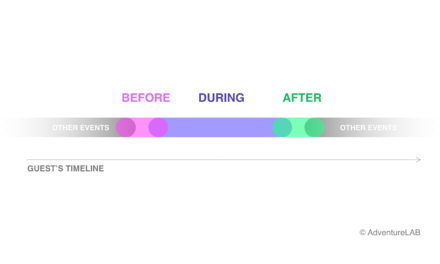Eight Recommendations For Designing Your Customer Experience Program
March 6, 2015Unless you have been performing your marketing tasks from under a rock in a cave somewhere, you will have noticed the increased focus on customer experiences and their value to the retailer.
Integrated experience strategies can help build and increase attention, amazement, satisfaction, loyalty and viral advocacy, as we store and recall our own experiences on various levels. Just as an example, look at what taste and smell can do to our memory of something. The actions of the store staff may be exactly the same as elsewhere, but that cup of chocolate on a cold day just made the difference.
While you consider that cup of hot chocolate, I would like to invite you to get into the strategic design mode of thinking about how to build an experience program for your brand. What may be the most important point here is that a successful customer experience program is not established with one gadget or one gimmick, but by adding a lasting dimension to the way customers experience your brand. It has to be part of your company culture and, if you do it right, the expense of something like a big event or a mobile app may be less than expected, perhaps even unnecessary. So let’s take a step back from that possible mistake of buying into a one-stop solution and look at other considerations that will help you get going:
Think Less Like A Communicator And More Like An Experience Facilitator
Education and careers in marketing communications have always focused mainly on communication. The primary vehicle for driving store traffic and sales for many retailers is still the images and words of the message. Communicate a reason for buying one product or more, lean back and watch the customers stampede into the stores. While your messaging is still important, you will truly have to think in terms of engagement and interaction beyond words to build a customer experience program. Look at the store, and every other touchpoint you share with your customers, as part of the framework where you facilitate what goes on, but cannot dictate it.
Visualise The Steps Your Customers Can Take
Part of designing your program is creating schematics of content, structure and possible occurrences, good or bad, from the pre-sale to the post-sale phase of the store experience. You cannot simply create a new store design and an endearing first-person story of how great the experience is going to be. You will need to explore the possible outcomes every step of the way, and you will need to plan for possible errors. What happens if something is not available, for example, or if something is broken?
Acknowledge That Customer Experience Design Is Much More Than Doing Events
There are many courses and programs that promise to get you up and running in a few days. Many of these will focus on running an event to draw traffic into the store. This is fine, but not enough. With isolated activities, they will either succeed or fail right there and then. Our interest in something can certainly be aroused by an exciting event, but our perception of things is strengthened and retained by a continuous string of occurrences. Not all of them need to be big events; in fact a continuous string of small events experienced by your customers will often be just perfect.
Leave Out Ideas That Do Not Make Any Sense
If anyone has to ask one too many times why something is going to be part of your customer experience program, there is a chance it should be left out. As with any emerging creative marketing discipline, there is always the chance that things get done just for the fun of it, not really adding to the overall purpose of your marketing activities. Sure, it can be fun slapping people with a fish on the street, but will it make them think fondly of your clothing brand? Now, if you were selling the collected works of Monty Python, it could perhaps make sense. It’s important to avoid significant disconnects, without overthinking what you are doing. Sometimes you will need to Kill Your Darlings.
Once You Think You Are Done, It’s Time To Get Started
There is a common misconception that once something is up and running, the project is done. Nothing could be further from the truth. Once you have finished the initial design of your customer experience program, the work truly begins. The ideas and tasks within have to be applied, evaluated and updated as part of the everyday lifecycle of your brand. To part ways with one-time event or campaign thinking, you will need to plan for the continued operations and management of your program, and assign the appropriate roles and champions.
Never Leave Your Customer Experience Management To Strangers
As the good ideas have evolved into your customer experience program, managing and updating it need to become part of your culture, not part of the cashflow of external consultants. External competencies are great for getting different perspectives, objective observations, out-of-the box thinking and innovations, and I will certainly implore you to use the right people at the right times for tasks like these. But the day-to-day operations and observations have to be handled by the people who are actually handling your customers. Asking someone else to do this is basically asking someone else to run your business.
Avoid Stressing Out Your Customers. Or, For That Matter, Your Employees
Sometimes, VIP treatment is being left alone, and every smart salesperson knows when to back off. You will need to consider the same dynamics in your customer experience design. Things cannot be going on all around the customers all the time. Sometimes you have to give people room to breathe and reflect, so they do not feel stressed. The fact that your policy is to not panic just because someone does not get deeply engaged in entertainment or interaction with you every minute can reflect positively on both your customers and your staff. It can create the right conditions for a dwelling space where people want to spend more time. Even theme park designers take into consideration that sometimes people need some time out on their own. The precise balance for your store is a unique choice.
There Is No Definitive List Of Customer Experience Design Guidelines
Speaking of unique choices, this list is only to get you started, and it acknowledges the fact that your customers and their journeys have unique attributes. There is no universal set of rules because products, people and places are not the same. As you move forward, you will learn more about what works best for you, and you will be able to set up your own list of guidelines for your brand experience, and the team that represents it.
Reinvent Retail by setting up your first customer experience program now to strengthen how your customers think of you. All it requires is taking the steps from thought to action, seeing things through the eyes of your customers, and balancing creativity with common sense to make certain your first steps are in the right direction.




